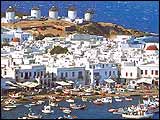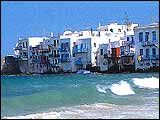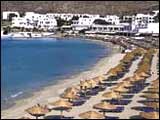|
 Mykonos is
the world’s famous island of the Aegean Sea as well as the most
cosmopolitan of all Greek islands. It attracts visitors from all over the
world including a lot of celebrities. The beautiful golden sandy beaches,
the lively atmosphere and the traditional cycladic architecture
represented by the numerous small churches and the houses, along with
little Venice make Mykonos an island to remember. The windmills constitute
one of the symbols of the island while the mascot of the island is
“Petros” the pelican
that lives at the port of “Hora the capital of the island. Although Mykonos
has no a historical back round there are 3 interesting museums to visit. For
further educational trips you should visit Delos isle, which in antiquity was
the most sacred island in the Greek world. Mykonos is
the world’s famous island of the Aegean Sea as well as the most
cosmopolitan of all Greek islands. It attracts visitors from all over the
world including a lot of celebrities. The beautiful golden sandy beaches,
the lively atmosphere and the traditional cycladic architecture
represented by the numerous small churches and the houses, along with
little Venice make Mykonos an island to remember. The windmills constitute
one of the symbols of the island while the mascot of the island is
“Petros” the pelican
that lives at the port of “Hora the capital of the island. Although Mykonos
has no a historical back round there are 3 interesting museums to visit. For
further educational trips you should visit Delos isle, which in antiquity was
the most sacred island in the Greek world. Museums

Archaeological Museum
Housed in a neo-classical building
of 1901, in the northeast side of “Hora”. It contains exhibits from the
nearby island of Rhenea, sculptures, pots and statuettes. Look for the big
vase of clay from the Trojan War. Folk Art Museum opened in 1962, contains
collections of furniture, ceramics, traditional costumes and traditional
musical instruments. Among the exhibits you will see
the first “Petros” the pelican, stuffed. the exhibits you will see
the first “Petros” the pelican, stuffed.
Nautical Museum
Opened in 1985, here you can see ships from the early Minoan period to the 19th
c, maps and documents and in general exhibits from the naval tradition of the
island.
Mykonos Town 
Mykonos is a prime example of Cycladic architecture. It consists of narrow
whitewashed alleyways, small churches, white houses with wooden doors and
windows and brightly – coloured balconies. In the colourful harbour where
small fishing boats and yachts coexist, where taverns, “ouzeris”, cafes and
shops are spread on the coastline, you will also see a pelican eating fish, it
is one of a series named Petros. Mykonos has all the necessary facilities of a
modern resort giving satisfaction both to visitors seeking an active and
cosmopolitan type of holiday and those who favour a more peaceful vacation.
Matogiannni with its chic shops, cafes and bars is where the island’s pulse
throbs. Nightlife in Mykonos is unique. Numerous clubs, discos, bars, pubs are
always full with people especially during summer time.
Little Venice

 Little
Venice is one of the most charming districts of Hora and one of the prettiest
places in the Cyclades. Its picturesque two - and three - storey houses, with
colorful balconies, windows and doors built right on the sea, form a unique
picture. Little Venice is the perfect spot from which to view the sunset. Little
Venice is one of the most charming districts of Hora and one of the prettiest
places in the Cyclades. Its picturesque two - and three - storey houses, with
colorful balconies, windows and doors built right on the sea, form a unique
picture. Little Venice is the perfect spot from which to view the sunset.
Shops 
A respective commercial action exists in Mykonos. You can go shopping or window
shopping in the fabulous boutiques which carry exclusive name brands, among them
outstanding Greek jewelers, souvenirs as well as works of art.
Restaurants

Katrin’s: One of the most famous and oldest restaurants on the island,
with classic French and Greek cuisine and excellent service. Caprice: It
is in little Venice area, next to the bar of the same name, with tables on the
water’s edge. It serves good traditional dishes. Philippi: Historic
spot in a lovely garden with good food. Mamacas: A beautiful garden with
trees near the main square, it offers good Greek cuisine. Sale Pepe:
Small restaurant with excellent Italian cuisine Taverna O Nikos: One of
the best taverns, with excellent Greek cooking. Taste its casserole dishes.
Beaches 
 Kalafatis:
One of the most organized beaches of Mykonos. Water sports facilities including
scuba diving and a beach bar are available. Psarou: A beautiful organized
beach with water sport facilities and a tavern for lunch. Elia: Another
popular organized big beach of the island. It offers water sports and two good
taverns. Plati Gialos: A sandy with crystal clear water beach, perhaps
the most visited beach of Mykonos. Small boats to the other southern beaches,
like Paraga, kalamopodi and Elia leave from here. Super Paradise: One of
the famous beaches in the Aegean, with crystal-clear blue water. It is preferred
by people of younger age and generally people who like to swim and swing at the
same time. Kalafatis:
One of the most organized beaches of Mykonos. Water sports facilities including
scuba diving and a beach bar are available. Psarou: A beautiful organized
beach with water sport facilities and a tavern for lunch. Elia: Another
popular organized big beach of the island. It offers water sports and two good
taverns. Plati Gialos: A sandy with crystal clear water beach, perhaps
the most visited beach of Mykonos. Small boats to the other southern beaches,
like Paraga, kalamopodi and Elia leave from here. Super Paradise: One of
the famous beaches in the Aegean, with crystal-clear blue water. It is preferred
by people of younger age and generally people who like to swim and swing at the
same time.
How to get there

By air: from Athens airport, Eleutherios Venizelos By ferry: from Piraeus port
DELOS 
Delos is a small, rectangular, waterless and
uninhabited island and one of the most important archaeological sites in
Greece where according to the myths god Apollo was born. The
archaeological sites cover almost the entire island, starting from the
harbour at the west side. You must explore the exhibits with a guide. The
most important ruins in this district are: · The temples of Apollo: The
three temples dedicated to Apollo · The Altar of Dionysos: Remains of a
huge phallic monument · The Lion Terrace: The famous lions of Delos, gift
from the Naxian’s. · The sacred lake: The place where Apollo was born. ·
Cleopatra’s House: A building (2nd c BC), which took its name from the two
headless statues of Cleopatra that where found in it. · The theatre: Built
in 2nd – 3rd c BC, it could seat 3.000 to 5.000 spectators. · House of
Dionysos, House of the Masks, House of the Dolphins, which contain
marvellous mosaics.
|